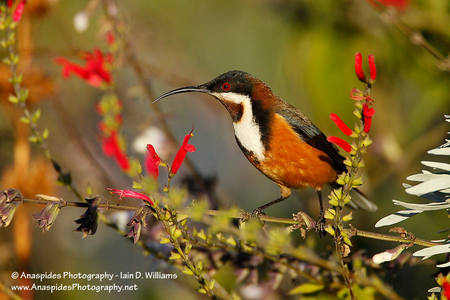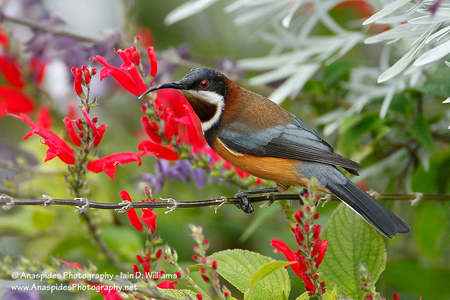Eastern Spinebills (Acanthorhynchus tenuirostris) - Tasmania
 Wednesday, May 20, 2015 at 6:19PM
Wednesday, May 20, 2015 at 6:19PM  The Eastern Spinebill (Acanthorhynchus tenuirostris) is a species of Australian honeyeater that is inhabits dry sclerophyll forests, scrub and woodland from Northern Queensland through New South Wales, Victoria, parts of South Australia and the Island state of Tasmania. The species is highly adaptable and is often found in urban gardens in which there are sufficient vegetation to act as cover and food.
The Eastern Spinebill (Acanthorhynchus tenuirostris) is a species of Australian honeyeater that is inhabits dry sclerophyll forests, scrub and woodland from Northern Queensland through New South Wales, Victoria, parts of South Australia and the Island state of Tasmania. The species is highly adaptable and is often found in urban gardens in which there are sufficient vegetation to act as cover and food.
LEFT: Male Eastern Spinebill feeds on introduced flowers (click to enlarge).
The eastern species is not to be confused with the Western Spinebill which inhabits Western Australia; this spinebill, although belonging to the same Genus is a separate species. Evolutionary scientists believe that both species derived from a cosmopolitan ancestor due to climatic change. At some time in the past, desertification separated the species into two geographical locations on each side of Australia. Over time, each population evolved into a distinct species.
Spinebills are small and fast and vary rarely perch for an extended period of time. To provide the energy to support their fast lifestyle the birds rely on nectar from a number of indigenous and introduced plants. The beak of the spinebill has evolved into a long and slender device that is ideal for removing nectar from a number of plants including the blooms of gum trees, mistletoe, heaths, grevilleas and banksias. In addition to nectar (akin to rocket fuel) spinebills frequently prey on small insects and other invertebrates which are often captured on the wing.
 The spinebill has evolved an interesting adaptation to counter against periods in which flowers are abundant, but the nectar supply is low. During mast flowering years, plants may product copious numbers of flowers, but not a lot of nectar. During these periods, the spinebill will store fat, increase the amount of time feeding, or lower its metabolic rate to a level similar to night-time levels.
The spinebill has evolved an interesting adaptation to counter against periods in which flowers are abundant, but the nectar supply is low. During mast flowering years, plants may product copious numbers of flowers, but not a lot of nectar. During these periods, the spinebill will store fat, increase the amount of time feeding, or lower its metabolic rate to a level similar to night-time levels.
LEFT: Female Eastern Spinebill. Note the differing pattern on the chest and the slightly drab colours in relation to the male in the upper image (click to enlarge).
Male spinebills sport rufus coloured feathers with a blaze of white across their chest. The colour can appear very bright, especially in the low light of the morning or afternoon. By comparison, females have rather dull colours. It is with these bright colours that the males present to the females, in the hope of a successful application to reproduction rights.
Spinebills breed from August through December and make a small cup-style nest constructed from bark and grass and lined with feathers. The clutch produced is usually two; however, four can be produced in good years. The female incubates the eggs for around 16 days. Both parents care and feed for the chicks.
To see further photographs of spinebills, navigate to the photograph archive and type in 'honeyeaters or spinebill'.
Glossary
Cosmopolitan – A term referring to wide ranging
Mast Flowering – Flowering events in which plants produce large numbers of flowers, often with a overall resultant decline in nectar.





